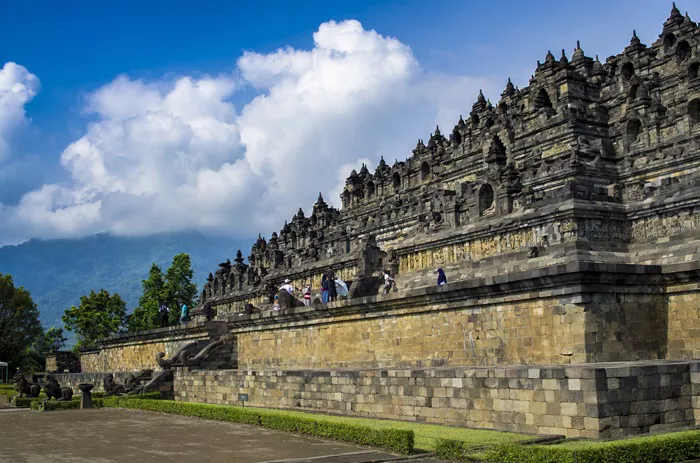Borobudur Temple is one of the most famous Buddhist temples in the world. Located in Central Java, Indonesia, it is a remarkable monument that attracts millions of visitors every year. This temple is not only an architectural masterpiece but also a sacred site that holds deep spiritual meaning for Buddhists everywhere. Understanding its history, architecture, and cultural importance helps us appreciate its true value.
History of Borobudur Temple
The Origins of Borobudur
Borobudur was built during the 8th and 9th centuries under the Sailendra Dynasty. This dynasty was known for its strong support of Mahayana Buddhism. The temple was constructed as a place for pilgrimage and spiritual practice. It is believed that the temple was completed around 825 CE.
Purpose and Spiritual Meaning
The temple was designed as a guide for pilgrims to follow the path to enlightenment. It represents the Buddhist cosmos and the journey toward nirvana. Pilgrims start at the base and walk upward through the levels of the temple, symbolizing the stages of spiritual progress.
Rediscovery and Restoration
For centuries, Borobudur was covered by volcanic ash and dense jungle growth. It was rediscovered in the early 19th century by Sir Thomas Stamford Raffles, a British governor of Java. Since then, it has undergone several restorations, including a major project by UNESCO in the 1970s. Today, Borobudur stands restored and protected as a UNESCO World Heritage Site.
Architecture of Borobudur Temple
Structure and Design
Borobudur is a large step pyramid built in the shape of a mandala, a symbolic Buddhist diagram of the universe. The temple is made from volcanic stone blocks without using any mortar. It has nine stacked platforms—six square and three circular—topped by a central dome.
Symbolism in Architecture
The temple’s design reflects Buddhist teachings. The base represents the world of desire, the middle levels symbolize the world of forms, and the upper circular platforms represent the formless world. The central dome at the top represents enlightenment or nirvana.
Reliefs and Statues
Borobudur is famous for its extensive bas-reliefs that cover the walls. These reliefs tell stories from the life of the Buddha and other Buddhist texts. There are over 2,600 relief panels. In addition, there are 504 Buddha statues placed throughout the temple. The statues are positioned inside stupas, which are bell-shaped structures with openings.
Temple Architecture and Engineering
The temple is a marvel of ancient temple architecture. Its construction shows advanced knowledge of engineering and aesthetics. The builders carefully planned drainage systems to protect the structure from heavy tropical rains.
Cultural Significance of Borobudur
Borobudur as a Pilgrimage Site
Borobudur remains an important pilgrimage destination for Buddhists. Each year, thousands gather to perform rituals, especially during Vesak Day, which celebrates the birth, enlightenment, and death of the Buddha. Pilgrims walk around the temple in a clockwise direction, following the path symbolizing a spiritual journey.
Symbol of Indonesian Heritage
Borobudur is a national treasure of Indonesia. It represents the rich cultural and religious history of the region. The temple is a source of pride for Indonesians and plays a key role in promoting cultural tourism.
Influence on Buddhist Art and Culture
The temple has influenced Buddhist art and architecture beyond Indonesia. Its style combines Indian Buddhist concepts with local Javanese art. Borobudur’s artistic achievements inspire Buddhist temples and carvings throughout Southeast Asia.
Preservation and Global Recognition
Thanks to efforts by local authorities and international organizations, Borobudur is well preserved. It is listed as a UNESCO World Heritage Site, recognizing its outstanding universal value. This recognition helps protect Borobudur for future generations to learn from and enjoy.
How Borobudur Reflects Buddhist Philosophy
The Path to Enlightenment
Borobudur’s design teaches the Buddhist path of self-purification and wisdom. The journey upward from the temple’s base to the top dome represents moving from ignorance to full enlightenment. This physical movement through the temple allows pilgrims to meditate on the teachings of the Buddha.
The Three Realms in Buddhism
The temple’s levels represent the three realms in Buddhist cosmology: Kamadhatu (the world of desire), Rupadhatu (the world of forms), and Arupadhatu (the formless world). This clear structure helps explain key Buddhist ideas in a visual and experiential way.
Impermanence and Harmony
The weathered stone and careful restoration remind visitors of impermanence—a central Buddhist teaching. At the same time, the temple’s harmony with its natural surroundings shows the Buddhist respect for nature and balance.
Visiting Borobudur Today
What to Expect
Visitors to Borobudur can explore the temple by walking around its terraces and viewing the detailed reliefs. Guided tours help explain the meanings behind the carvings and statues. The sunrise view from the top is a popular highlight.
Respectful Practices
Because Borobudur is a sacred site, visitors should behave respectfully. This includes dressing modestly, speaking quietly, and following local customs during religious ceremonies. Respect helps maintain the temple’s spiritual atmosphere.
Nearby Attractions
The region around Borobudur is rich in cultural and natural attractions. Visitors often combine their trip with visits to other buddhist temples in Java, as well as natural sites like Mount Merapi and local villages.
Conclusion
Borobudur Temple is more than a historic monument. It is a living symbol of Buddhist philosophy, art, and culture. Its rich history, stunning architecture, and spiritual significance make it a treasure for both Buddhists and travelers worldwide. By visiting Borobudur or learning about it, we connect with the timeless teachings of the Buddha and the human quest for peace and wisdom.

